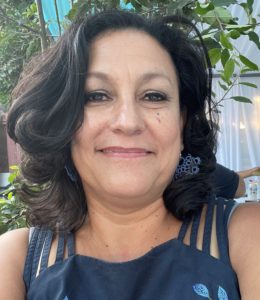We recently spoke with Maria Guerra, kindergarten teacher at Grape Street Elementary School. She talked about her journey to becoming an educator, how the pandemic impacted her teaching style, and how seeing students grow is the most rewarding part of her job.

Even though Maria Guerra’s first job out of high school was as a teaching assistant at Grape Street Elementary, being a teacher wasn’t initially part of her career plans. She had friends who worked at the school, and when they asked if she wanted to become a teaching assistant, she thought: why not?
“I was in college, so I started out with three hours in the mornings — and I really started to like it,” Maria recalls. She worked with (and learned from) several amazing teachers, including her longtime mentor Sharon Mason, and before long, she knew it was what she wanted to do.
There was also another reason. A high school friend of Maria’s, Antonieta, had attended Stanford University to become a teacher and come back to their community to teach. Before she was able to realize that dream, Antonieta was involved in a fatal car accident. Deciding she was going to continue Antonieta’s work, Maria switched from an undecided major at California State University, Dominguez Hills to a Liberal Studies major, a program designed specifically for students who wanted to become elementary or special education teachers.
As a part-time student, it took Maria eight years to get her Bachelor of Arts degree and another two to obtain her teaching credentials. After receiving her credentials, she taught kindergarten and Spanish — two things she loved. “There were many first-generation students in my class, and I loved working with kids like me,” says Maria, who was born in Mexico. Her Spanish-speaking ability granted her a Bilingual, Cross-Cultural, Language and Academic Development (BCLAD) credential, and she was paired with another teacher to deliver both English and Spanish instruction to the students. When Proposition 227 eliminated many of the state’s bilingual classes, Maria decided to stay at Grape Street and teach in English. She’s spent over 30 years at the school, 28 of those years as a kindergarten teacher.
Maria has experienced many changes in her years of teaching, and the pandemic added yet another layer. “Before the pandemic, I was very hesitant to use technology — I was very old school,” she laughs. “I had just started using a digital projector!” The shift to remote learning meant she needed to quickly get up to speed with several digital tools and platforms to provide instruction — YouTube, Zoom, Schoology, Amplify, Zearn, Eureka, and IXL Learning, to name a few.
Not only did all of these platforms help Maria teach her students effectively throughout the pandemic, but they also helped her with her own mindset shift. Prior to the pandemic, she wasn’t sure how students would learn in a 100% remote environment. Now, she recognizes while it may not be an ideal solution for every student, many of her students did well with remote learning. “Technology can really help students,” she says, noting that she still uses many of the digital platforms to augment her teaching even though in-person school is back in session.
Maria knows she has an important role to play when it comes to helping students learn more about their future, specifically around college and career pathways. Recently, an unexpected memory from Maria’s past created an opportunity for connection with her students. While sifting through old VHS tapes in her classroom, she found a video that contained both her college graduation ceremony and a clip of her initial days as a teacher. She showed it to her students, and it initiated an exciting conversation about college. “I told them that that could be them one day,” she says.
The video is one example of Maria’s educational philosophy: That education should be attainable for everyone. “I come from a country where education isn’t as easily accessible as it is here,” she says. She feels her role is to facilitate that accessibility. “Every student in my classroom has the ability and potential to learn — and I’m their guide,” she says.
This potential is what Maria counts as the most rewarding part of teaching. “In many cases, I’m my students’ first or second teacher besides their parents,” she says. “To see their progression and growth — not just physically, but socially and mentally — is amazing.”
It’s the same progression Maria sees in herself and her fellow teachers as well. “Teachers are lifelong learners,” she says. “I see myself teaching very differently than I did even a few years ago.” She believes schools prioritizing diversity, equity, and inclusion is a big part of that. “It’s important to differentiate your teaching based on a student’s background and experiences,” she says. “You always have to look through the lens of the student being the priority.”
